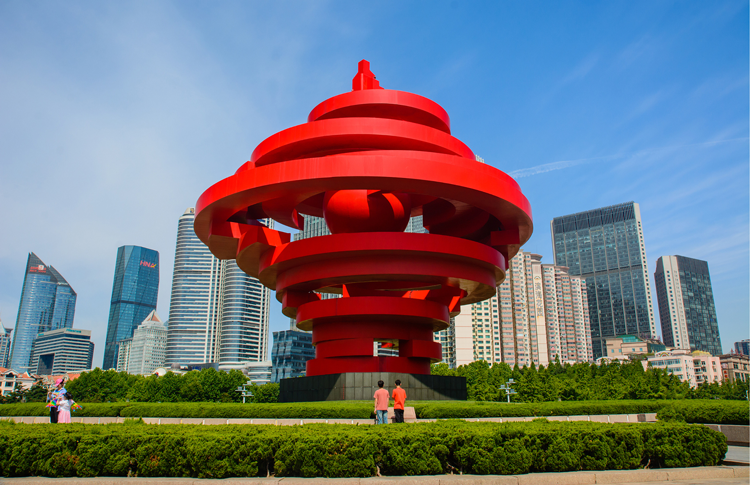
把守黄渤海之滨,北连京津冀,南通长三角,外接东北亚,山东是中国的工农业和服贸大省,其GDP多年蝉联中国第三。然而近年来,受到产业结构落后、创新后劲不足等因素影响,山东经济走上了“新旧动能转换”的剧变之路,当地法律服务市场也面临着新机遇和挑战。
2020年余额即将告尽,在这个内忧外患不断加击的多舛之年,山东的表现如何?
从2020年上半年数据来看,山东交出了一份还不错的成绩单。上半年,山东GDP总值为33025.8亿元,虽然同比下降0.2%,但依旧位居全国第三。在上半年中国GDP百强城市中,山东的16座地级市中有11城上榜。
山东是中国的传统经济大省。改革开放后,山东借助农业快速发展;2000年后,以石化、炼油为代表的重工业崛起,山东继续成为中国不可忽视的经济体。
不仅如此,苏宁消费金融研究中心主任付一夫曾在一篇文章中写道,“深入到城市层面,论经济体量,山东境内每一个城市都不是泛泛之辈……山东内部城市的均衡发展,着实是一项了不起的成就。”
然而成就背后,山东的发展也存在着不小隐忧。
首先是经济体量大,但后劲不足。Wind数据显示,2011年前,山东GDP增速始终保持在10%以上,但自2012年起便现颓势。2018年山东GDP增速为6.4%,开始低于全国6.6%的增速,2019年山东增速为5.5%,全国则为6.1%。
山东的第二个问题,则在于城市发展虽然均衡,却没有能起到领头作用的超级城市。
在山东的16个地级市中,目前只有青岛GDP过万亿,济南GDP准万亿,然而两城在全国的排名只有14和21位。山东还没有一座人口过千万的城市,且年轻人正在不断流出:据齐鲁晚报报道,2019年山东16市毕业生平均留存率仅为23.54%,流失的毕业生中,有七成去了京津冀或长三角。
山东的“减法”与“加法”
山东经济是否出了问题?出了什么问题?这其实不是个新话题。
2018年1月,国务院批复了《新旧动能转换综合试验区建设总体方案》,同意山东开展“新旧动能转换”。文件出台一个月后,山东省委书记刘家义在一份讲话中生动揭示了山东经济的问题:结构老化,创新不足。
“全国互联网企业百强我省只有2家。服务业仍以传统的交通、商贸、餐饮住宿等传统服务业为主。PCT(《专利合作条约》)国际专利申请量我省1399件,仅为广东的5.8%。” 刘家义说,“从能耗水平看,我省能耗总量、主要污染物排放总量均居全国前列,能源消耗占全国的9%。”
随后,山东公布了经济结构转型“三步走”目标:到2022年,山东经济要变为以“四新”(即新技术、新产业、新业态、新模式)为主导,新经济对经济增加值占比达到30%;2028年完成这一轮新旧动能转换;2035年则成为全国领先大省。
《方案》公布已两年,山东情况如何?
在“减法”方面,根据山东政府数据,过去几年山东关停化工企业1500多家,化工园区从199家压减到85家。而在“加法”层面,根据山东省政府数据,2019年山东第三产业经济占比提升至53%;2019年山东新增高新技术企业2500余家,高新技术产业产值占工业总产值的比重在2020年上半年达到44.4%。
深化开放
与此同时,山东的对外开放也被提升到了国家战略高度。
2019年8月,经国务院批复,中国(山东)自贸试验区正式设立,其发展重点为“培育贸易新业态新模式;扩大人民币跨境使用;加快发展海洋特色产业;深化中日韩区域经济合作,探索三国地方经济合作”。同年10月,中国—上合组织地方经贸合作示范区也在山东落地。
除青岛、烟台等传统对外经贸发达的城市,山东其他城市也感受到了深化开放带来的益处。
以位于山东北部的滨州市为例,过去几年,滨州打造了“世界级高端铝业基地”,吸引来一众外资企业。2019年8月,韩国载元产业株式会社的两个项目落地,实现了滨州日韩招商“零突破”。“截至目前,滨州日韩招商项目共16个,投资领域遍布铝业、高端化工、中药业、高效农业、海洋生物等。” 山东国曜(滨州)律师事务所主任索琳律师说。
“对外经贸蓬勃发展,带动了涉外法律业务发展。”滨州市律师协会副会长张跃军介绍说,“市律协组建了涉外律师人才库,目前主要就涉外经贸合同审查、涉外企业合规审查、涉外仲裁提供服务。”
山东国曜(临沂)律师事务所主任胡金涛律师同样观察到了涉外经济在鲁南城市临沂的发展。“近年来临沂越来越多企业‘走出去’,越来越多外资‘引进来’,对外贸易和外资企业迅速崛起。”他说,“然而临沂涉外业务案源基本上都跑到了济南、青岛和北上广。涉外法律业务是块比较大的产业,一直未能引起临沂律师行业的重视,我们希望当地加快相关人才培养。”
济南/聊城/滨州:省会经济圈“谋变”
在经济结构由旧转新的过程中,超级城市无疑起到了关键作用,而如上文所述,缺乏超级城市却一直是山东的软肋。
实际上,早在2017年,山东就意识到了发展都市圈的重要性。根据当年印发的《山东半岛城市群发展规划(2016-2030年)》,到2030年,山东半岛城市群要全面建成发展活力足、一体化程度高、核心竞争力强的现代化国家级城市群。
细分之下,山东半岛城市群可以划分为三大空间:以济南为核心的济南城市群、以青烟威为核心的胶东城市群,以及以临沂等为中心的鲁南城市群。
在各城市圈中,山东首当其冲发展的就是以济南为中心的省会经济圈。“省会圈”包括济南、淄博、泰安、聊城、德州、滨州、东营7市,将通过一体化发展,未来成为京沪之间的区域性经济中心、金融中心、物流中心和科技创新中心。
谈到“省会圈”建设,大成济南分所主任项浩律师特别强调了“融合互通”,这包括了“基础设施互联互通、生态环境共保联治、文化交流互鉴、优化配置各类要素资源”等等。项律师告诉ALB,目前济南都市圈已经从交通入手,开启了包括都市圈“高速大四环”、市域铁路环线、济南北站在内的一系列工程。
而对“省会圈”内的其他城市来说,未来它们的发展依托于济南,也是济南不可或缺的补充。
以济南以北的滨州为例,国曜的索琳律师告诉ALB,“济南滨州同为沿黄河流域城市,省会要实现更快更好发展,离不开滨州的支持。两座城市应该实现在产业、人才、基础设施、公共资源等方面深化对接。”
具体到未来在省会圈中扮演的角色,索律师强调了滨州的区位和交通优势。“第一,滨州通过德商高铁和济滨铁路的修建,会成为省会经济圈重要节点城市;第二,滨州港是济南都市圈最近的出海通道。借助京沪高铁二通道,滨州港可以将济南都市圈带入国家‘一带一路’建设和京津冀一体化的整体格局中去。”
再以济南以西的聊城为例,在山东国曜(聊城)律师事务所执行主任高英国律师看来,借助本地特色产业,未来聊城的角色有三个:一是借助农业标准化生产,成为济南乃至省会经济圈的“米袋子”“菜篮子”;二是通过承接延长产业链,成为济南的工业配套基地;三则是做好“江北水城”品牌,成为济南的“西花园”。
“资源型行业面临投资相对不足、融资困难、需要战略转型等现实问题,疫情发生后,这种困难更加明显。”
- 索琳,国曜律师事务所
增强区域联通互补之外,做好省会圈的“加减法”也是关键。
和山东其他地方类似,省会圈也以传统资源型产业、大型国企见长。“资源型行业面临投资相对不足、融资困难、需要战略转型等现实问题,疫情发生后,这种困难更加明显。”索琳律师说。
过去几年,省会圈加快推动传统产业转型升级,用项浩律师的话来说,既有“‘腾笼换鸟’,也有‘老树发新芽’”。以滨州为例,将传统产业打造成为高端石化产业基地、“世界级家纺产业集群先行区”,以及高附加值食品加工业;而在聊城,传统装备制造业开始向高端化、数字化、智能化转型,精细化工产业、有色金属深加工产业、黑色金属产业等也开启转型。
随着新旧动能转化深入,项浩律师发现,律所越来越多承担了“为改制企业提供法律服务方案,并制定切实可行的实施方案,制定资产重组、企业改制方案等”工作。高英国律师则补充道:“企业产生了许多新需求,如并购、投融资、股权设计、运营模式、知识产权保护等。”
她举了几个例子:近年聊城推出了以“聊·胜一筹!”为品牌的名特优新农产品,“带来了知识产权保护及电子商务领域等新的法律需求,如商标注册与保护、不正当竞争防范、电子合同签署及履行、电子证据固定等”;强调生态环境保护则给企业带来环保方面的法律风险;另外,“一些新技术产业的发展需要引进资金、技术支持,就可能产生并购、投融资等法律需求”。
索琳律师则从另外的角度观察到传统企业的新需求:“企业普遍前置法律审核,深化法律风险防范机制,加快促进法律管理与经营管理的深度融合,将法律审核嵌入管理流程。”
索律师的观察得到了当地总法的赞同。陈萧是山东金蔡伦集团总经理,金蔡伦是一家拥有20余历史的传统造纸企业,但陈萧告诉ALB,“近几年随着新一代信息技术和制造业深度融合,我们也加速推动了大数据、物联网、人工智能等技术的应用,打造互联网+制造业的工作模式”。
过去,陈萧带领的法务部主要负责合规、风控、纠纷解决、重大项目法律风险论证等工作,而“随着互联网+制造业的发展,企业生产涉及到数据采集、云端计算、分析应用等场景,出现了企业数据保护、网络平台安全问题、网络公司阶段性服务合同管理等新问题,都要求法务进行知识拓展”。她说。
除了职责扩展,陈萧也感受到了法务部角色和对外部律所需求的变化。“事后解决延伸到了事前。甚至企业大的投资、发展方向,都需要法务部参与提供前瞻性意见……因此,我们希望外部律所能够跟随企业发展步伐,熟悉新兴产业,掌握相关法律知识,提早告知企业规避不必要的麻烦,能够给重大项目决策做出前瞻性提醒。”
旧产业升级外,新产业也加速在“省会圈”落地。
新产业中,有的属于“原生”,例如济南的半导体高功率芯片、新一代信息技术、智能制造和高端装备、量子信息技术;聊城的新材料、新能源汽车、生物医药、智能装备、氢能动力、智能机器人产业等。
有的则属于“外引”,例如济南引入了山东产业技术研究院、山东高等技术研究院、国家超级计算济南中心等;聊城引进了万达欢乐小镇、中铁电气化集团高铁接触导线研发生产基地、智汇谷·阿里云创新中心等32个投资项目;滨州则打造了渤海先进技术研究院、魏桥国科(滨州)科技园等。
谈到新产业给法律服务带来的变化,索琳律师说:“新经济形势下,要求法律服务既有综合性,也要重点突出。重点突出,一是指对重点行业的研判和市场开拓,二是指法律服务提供者自身也要具备相应的专业化能力。”
高英国律师则补充了新产业所需要的几项重点法律服务能力:“例如新技术引进和创新引发的无形资产评估、知识产权保护等;新兴产业企业的融资模式搭建和风险防范;新兴产业短期内产业化高峰可能导致区域内产业趋同、低端产能过剩,或者在设计、生产环节因技术不成熟出现问题,这些风险都可能引发后续法律问题。”
高律师的观察特别得到了中国建设银行滨州市分行法务部主任王夫刚的赞同。王主任告诉ALB,虽然银行并非新产业成员,但作为为新产业发展提供金融服务的机构,其近年面临的风险和新产业是伴生的。“银行和企业的合作经常面临信息不对称问题,导致银行对企业或企业所在的行业法律风险认识不足。”他说,“我们希望律所能够提供对企业及其所属行业的专业化法律风险评估,这类服务在新经营模式及相关风险频现的当下尤为重要。”
青岛:创新与开放加速
位于胶东半岛的青岛依山傍海,这座气候温和的宜居城市“靠港而生,因贸而兴”,是山东经济最发达的地方。
青岛外贸繁荣,即便是受新冠疫情影响的2020年,前8个月,青岛市外贸进出口总值也达3955.4亿元,占同期山东省进出口总值的29.6%。在《2020年中国对外贸易500强企业排名报告》中,青岛共有6家企业上榜。
自2018年上海合作组织峰会在青岛召开后,青岛就被赋予了极高的开放高度。 山东省政府2020年初发布的《关于加快胶东经济圈一体化发展的指导意见》再次指出:以青岛为中心的胶东经济圈面向日韩,有天然的开放优势,要成长为“一带一路”国际合作新平台。
寻求新发展,需要加速解决老问题。大成青岛分所主任牟云春律师告诉ALB,青岛传统产业面临的问题和山东其他城市具有共性,就在9月底,青岛出台了《关于推动传统产业高质量发展的意见》支持政策,“相信新政策的效果将在今后实践中得到落实和检验”。牟律师说。
他继而指出,“新政策推动传统产业升级,反映在法律服务上,体现在产权界定、股权设计、重组、转让,商业模式理顺,围绕新产品的开发相关的知识产权服务、一系列上下游产业链的合同设计,与就业相关的劳动合同处理等等。”
与此同时,新产业也在青岛落地。过去几年,伴随西海岸新区、蓝谷核心区、高新区、胶东临空经济示范区等设立,牟律师观察到了新材料、节能环保、航空经济、邮轮游艇、海洋生物医药、工业机器人、海洋仪器装备、海水淡化装备、海洋新能源、3D打印等领域的兴起。
“新兴产业要求律师调整知识结构,必须了解新兴产业的特点和规律,才能给当事人提供精准服务。”他指出。
谈到未来青岛法律服务市场的发展趋势,牟律师着重指出两点。首先是伴随“对外开放步伐加快,涉外业务需求量增加,并对律师素质提出了更高要求”;其次是“伴随国家发展多层次资本市场战略和新兴产业高速发展,以及上市公司注册制的逐步放开,围绕《公司法》《证券法》的上市、并购重组业务将成为‘兵家必争之地’”。
在这样的背景下,牟律师认为,整个青岛法律服务市场都面临着“行业重新洗牌”的挑战。
临沂:鲁南“后来居上”
鲁南经济圈以临沂、枣庄、济宁、菏泽四城为核心。2020年,鲁南城市实现“逆袭”,以临沂为例,在2020上半年山东城市五强榜中,临沂跃升两位,来到第五,全国排名则升至第47位。
在“除旧迎新”的喧闹中,鲁南城市却表现出难得的沉稳,没有急于抛弃传统产业,而是在认清自身资源后,定制出“黄河生态”“一带一路”“乡村振兴”的发展规划。
以临沂为例,国曜的胡金涛律师告诉ALB,“传统产业是临沂的支柱,特别是机械、冶金、食品、化工、建材、医药、木业、纺织服装八大传统产业。临沂市为传统产业注入创新、资金、信息、品牌新元素,加上新技术、新业态、新模式,促进传统产业提质增效”。数据佐证了“变旧为新”的效果:2020年上半年,上述产业增长达5.5%。
胡律师举出了几个实例:在食品行业,绿爱公司建设共享工厂,实现了“大数据在线设计、 互联网数字印刷、工业 4.0 智能制造”;在医药行业,鲁南制药集团打造了支持医药研发的微球协同创新平台;在农业领域,农业“新六产”、医养健康、智能制造、数字经济成为发展关键。
同时,借力城市发展,过去几年中,华大基因、华为大数据、新松机器人等前沿项目纷纷落户临沂。此外,新开工的新明辉仓储物流园项目将以智慧物流支持“中国北方最大物流基地”临沂商城的贸易。“未来临沂将成为鲁南经济圈和山东半岛城市圈中的智慧物流基地,起到承上启下、连通八方的作用。”胡律师告诉ALB。
“临沂律师行业市场固化,传统诉讼业务占据了90%左右比例。传统产业转型和高科技新兴产业发展,对律师行业产生了巨大冲击。”
- 胡金涛,国曜律师事务所
经济发展必然带动法律行业发展。临沂市律师协会会长张兆伟告诉ALB,截至2019年底,临沂共有律师事务所153家,律师2144人,同比增长16.8%。当地律师扮演的社会角色也愈发重要。“律师积极为临沂市各级政府、单位提供法律服务与规范;配合政府工作组对国有僵尸企业进行破产重整、清算;针对私营企业经营管理中遇到的难题,为企业提供非诉讼团体法律服务。”张会长介绍道。
法律行业快速发展背后,胡律师也分享了些许隐忧。“临沂律师行业市场固化,传统诉讼业务占据了90%左右比例。传统产业转型和高科技新兴产业发展,对律师行业产生了巨大冲击。”他说,“尤其是高新技术产业领域的法律问题,是目前临沂律师不能及时应对的难题,导致优质案源严重流失……我们急需熟悉新兴产业领域非诉、知识产权专利诉讼及高新技术企业上市、涉外等法律业务的人才,当地律师必须尽快提升相应能力。”
法律产业面临机遇和挑战
与山东经济面临的问题类似,思维传统、转型难、人才不足、专业化及创新力不足等,也是山东法律市场面临的挑战。
受访律师指出,已经在中国法律市场被验证为有效的规模化发展,在山东还没能完全展开。以临沂为例,胡金涛律师告诉ALB,目前临沂的律师事务所中,约六成为10人以下律所,50人以上的只有6家,表现出“律师事务所多而杂,法律服务市场混乱,法律服务费较低”的特点。同样的情况也存在于滨州。滨州律协张跃军副会长说,滨州人数最多的律所执业律师也仅有33人,“缺乏专业精深的服务团队和律师人才,个案和整体收费不高”。
“当事人咨询的问题越来越专业、繁杂,以前万金油式的律师已逐渐不能适应法律服务市场需求,很多律师不再单打独斗、身兼数职,而开始寻求团队化、专业化发展。”
- 高英国,国曜律师事务所
山东法律市场的另一个特点,则是对专业化团队和服务的迫切呼求。
高英国律师观察到,近年来“当事人咨询的问题越来越专业、繁杂,以前万金油式的律师已逐渐不能适应法律服务市场需求,很多律师不再单打独斗、身兼数职,而开始寻求团队化、专业化发展”;临沂律协张兆伟会长则分享道,临沂目前已经活跃着“形成服务特色的法律团体和专业特色的个人律师”。
在索琳律师看来,只要做好专业化,规模化并非唯一的发展之道。她分享道:“近年来滨州律师事务所之间的竞争变得更加立体,律师行业生态也更加多彩。各家律所选择了或是精品所,或是规模所,或是联盟所等不同发展模式。”
在胡金涛律师看来,固守传统经营管理模式,会成为山东律所实现专业化转变的桎梏之一。他以临沂为例,“律所几乎是清一色的提成制,许多律师因为算计管理费、单件费用以及社保费用而经常跳槽,执业5年以上的律师经常拼凑三五个人作为合伙人成立新所,根本不会考虑发展问题”。
“律师应当适应市场发展,律所改革势在必行,规模化、团队化、专业化、高效化一体的现代化律所必须提上改革日程,这也是临沂法律服务市场对律师的新要求。”他指出。
索琳律师也坦言:“随着经济发展,企业的法律服务需求已经越来越高端专业,而本地法律服务市场却仍在传统模式中徘徊。法律服务需求是巨大的,如何从恶性竞争的红海转向专业化服务的蓝海,既是我们面临的挑战,也是我们的机遇。”
然而,在王夫刚主任看来,法律行业和市场发展尚不匹配的状态,恰恰说明“当地法律市场的空间非常大”。他以滨州为例,“虽然城市不大,上市公司却不少”。在他看来,当地律所应该抓住服务这类企业的机会,“伴随企业成长,为企业量身定做法律合规服务方案”。
正如王主任所观察的,山东法律市场近年确实发展迅速。除上文提到临沂律师2019年同比增长达16.8%外,聊城律协秘书长闫光瑜告诉ALB,自2012年起,聊城律师人数和收入的年增幅在30~50%之间;滨州律协张跃军副会长则说,与2017年相比,滨州律所数量增长约26%,律师执业人数增幅约21%。
谈及增长原因,闫秘书长认为有两个:一是法治意识增强;二是经济发展迅猛,“律师就是经济发展的晴雨表”。
在索琳律师看来,经济发展给律师既带来机会,也带来挑战。“同一业务,每一年都会面临市场、客户、工作内容的改变,某一新兴行业的崛起,也会促使很多专业律师的业务重心发生转变……同时,经济发展、全球规则变化以及企业面临的问题,也将成为律所和律师必须面对的新挑战。”
面对挑战,闫秘书长态度乐观:“任何业务对律师来讲都是挑战,律师行业本身就是一个不断自我学习的行业。我相信有业务就有需求,有需求就有压力。”
ALB and SD Guoyao Law Firm jointly present: Shandong Embracing the New
Shandong, a coastal province south of the Beijing metropolitan region and north of the Yangtze River Delta, is a major industrial, agricultural, and trading hub in China as well as a gateway to Northeast Asia. For years, the province has recorded the third-largest GDP in China. Its economy is undergoing drastic changes, and the local legal market is also seeing new opportunities and challenges.
With a turbulent 2020 coming to an end, one might wonder how Shandong Province has coped during these difficult times.
According to data from the first half of 2020, Shandong recorded a GDP of 3.3 trillion yuan ($450 billion), maintaining its third-place ranking in China. Eleven cities from the province were also among the 100 Chinese cities with the highest GDP in the same period.
Shandong is one of China’s economic powerhouse provinces. After China’s reform and opening up happened, Shandong experienced rapid economic growth thanks to its agricultural sector. With the rise of heavy industries such as petrochemicals and oil refining, Shandong continued to grow as a prominent economy after 2000.
Fu Yifu, director of the Suning Institute of Finance, says that every city in Shandong province carries a large economic weight and the province has achieved balanced urban development among its cities.
Despite these achievements, there are concerns about Shandong's development.
First, the region’s large economy is losing steam. Data from Wind shows that Shandong’s GDP growth remained above 10 percent before 2011 but has been slowing since 2012. In 2019, Shandong’s GDP growth was 5.5 percent, lower than the national rate of 6.1 percent.
Second, despite balanced urban development amongst its cities, there are no megacities that can play a leading role.
Among the 16 prefecture-level cities in Shandong, only Qingdao has a GDP exceeding 1 trillion yuan. There are no cities in Shandong with over 10 million people, and young people are constantly leaving. In 2019, only 23.5 percent of local graduates stayed in Shandong province, with the rest moving to the Jingjinji metropolitan region or the Yangtze River Delta.
TRANSFORMING OLD INTO NEW
There has been discussion on the economic challenges faced by Shandong.
In January 2018, the State Council approved a blueprint to establish a pilot zone in Shandong to innovate traditional industries. A month later, Liu Jiayi, secretary of the Shandong Provincial Party Committee, cited data that revealed the economic challenges in Shandong: outdated structures and a lack of innovation.
“Among the top 100 internet companies in China, only two of them are from Shandong. The service industry is still dominated by traditional sectors such as transportation, commerce, catering, and hospitality. Shandong only recorded 1,399 international patent applications under the PCT (Patent Cooperation Treaty), which is only 5.8 percent of Guangdong’s,” Liu said.
“In terms of energy consumption, Shandong's total energy consumption and total emissions of major pollutants are among the top in the country, and we account for 9 percent of the country’s energy consumption."
Subsequently, Shandong unveiled the “three-step” goal of economic structural transformation. By 2022, Shandong’s economy will be dominated by the “four news”, namely new technologies, new industries, new business forms and models, and the new economy will account for 30 percent of economic growth. By 2028, the province will complete transforming the old industries. By 2035, it will cement its position as a leading province in the country.
Meanwhile, the opening of Shandong’s market has also become a national strategy.
In August 2019, the China (Shandong) Pilot Free Trade Zone was established, with a focus on fostering new trade models, expanding the cross-border use of the renminbi, accelerating the development of marine industries, and deepening regional economic cooperation between China, Japan and South Korea. In October, the China-SCO Local Economic and Trade Cooperation Demonstration Zone was also launched in Shandong.
Besides trading cities such as Qingdao and Yantai, other cities in Shandong province are also enjoying the benefits of further opening up.
An example would be Binzhou in northern Shandong. In the past few years, Binzhou has built a high-end aluminum industry base and attracted many foreign-invested enterprises. “To date, Binzhou has commenced 16 projects that aim to attract investment from Japan and South Korea for industries ranging from aluminum to high-end chemicals, traditional Chinese medicine, high-efficiency agriculture and marine biology," says Suo Lin, director at Shandong Guoyao Law Firm’s Binzhou office.
“The robust development of foreign trade has driven the growth of foreign-related legal services,” says Zhang Yuejun, vice chairman of Binzhou Lawyers Association. “The association has established a talent pool for foreign-related legal services, and it now mainly provides services in reviewing foreign trade contracts, compliance reviews of foreign-related enterprises and foreign-related arbitration."
JINAN, LIAOCHENG AND BINZHOU: SEEKING CHANGES
The megacities play a key role in economic structural transformation. As early as in 2017, Shandong authorities were aware it was important to develop a metropolitan area. According to the Shandong Peninsula Urban Agglomeration Development Plan (2016-2030), Shandong should have established modern metropolitan areas that are dynamic, highly integrated, and highly competitive by 2030.
In particular, there will be three metropolitan areas forming around the cities of Jinan, Qingdao and Linyi on the Shandong Peninsula.
Developing the economic zone centred around Jinan, known as the Capital Economic Circle, is a main priority. Covering seven cities, the metropolitan area is expected to become a regional economic, financial, logistics, and technological innovation centre.
When talking about the development of a capital economic circle, Xiang Hao, director of Dentons Jinan office, emphasizes the integration and interconnection of infrastructure, environmental protection and governance, culture, and resources.
Other cities in the capital economic circle will need to rely on Jinan to boost their development, and they will also complement Jinan’s development.
One example would be Binzhou, a city north of Jinan. “Both Jinan and Binzhou are on the Yellow River. The provincial capital needs the support of Binzhou to achieve faster and better development,” Suo from Guoyao tells ALB.
Regarding Binzhou’s future role in the capital economic circle, Suo spoke of the city’s strategic location and accessibility: "First, Binzhou will become an important node city in the capital economic circle thanks to the construction of high-speed railways. Second, the Binzhou Port is the closest port to the Jinan metropolitan area.”
Another example would be Liaocheng, a city west of Jinan. Gao Yingguo, executive director of Shandong Guoyao Law Firm’s Liaocheng Office, believes the city will play three roles: a food supplier for the capital economic circle, a base for ancillary industries, and Jinan’s “west garden.”
"Resource-based industries are facing issues such as insufficient investment, financing challenges, and the need for strategic transformation. The outbreak of the pandemic further highlighted these issues."
- Suo Lin, Shandong Guoyao Law Firm
In addition to enhancing regional connectivity and complementarity, facilitating transformation in the capital economic circle is also a key.
Like other places in Shandong, the capital economic circle is also known for traditional resource-based industries and large state-owned enterprises. "Resource-based industries are facing issues such as insufficient investment, financing challenges, and the need for strategic transformation. The outbreak of the pandemic further highlighted these issues," Suo says.
In the past few years, the capital economic circle has accelerated the transformation and upgrading of traditional industries. In Binzhou, traditional industries are transforming into a high-end petrochemical industry base, a home textile industry cluster pilot zone, and a high value-added food processing industry. In Liaocheng, the traditional equipment manufacturing industry is going high-end, digital, and intelligent.
As the transformation of traditional industries proceeds at full swing, Xiang of Dentons Jinan has noticed that law firms are increasingly providing legal services to companies that are to be restructured, as well as formulating actionable implementation plans and designing asset restructuring and corporate restructuring plans for these companies. Guoyao’s Gao adds: "Companies have many new needs, such as M&A, investment and financing, equity design, operating models, intellectual property protection and so forth."
She cites a few examples. In recent years, Liaocheng has launched its own agricultural brand, which has created new legal needs in intellectual property rights protection and e-commerce. An emphasis on environmental protection has brought legal risks to companies in this regard. Furthermore, the development of new tech industries needs capital and technologies, which has created legal needs in M&A, investment, and financing.
Suo has noticed the new needs from traditional enterprises from another perspective. She says: "These companies have generally established the legal risk control function, and they accelerate the integration of law and business to include legal review in their management.”
Besides upgrading the old industries, new industries are also stepping up their presence in the capital economic circle faster.
Some of the new industries are homebred, such as semiconductor high-power chips, new-generation information technology, intelligent manufacturing and high-end equipment, and quantum information technology in Jinan, as well as new materials, new energy vehicles, biopharmaceutical, smart equipment, and hydrogen power in Liaocheng.
Some are introduced. For example, Jinan introduced the Shandong Industrial Technology Research Institute, the Shandong Institute of Advanced Technology, and the National Supercomputing Center. Liaocheng introduced 32 investment projects, including the Wanda Happy Town and Alibaba Cloud Innovation Center. Meanwhile, Binzhou has established the Bohai Advanced Technology Research Institute and the Weiqiao National Science and Technology Park.
Speaking of the changes brought by the new industries to legal services, Suo says: "Under a new economic era, legal services are required to be both comprehensive and targeted. What I mean by targeted is that there need to be analyses and marketing for a key industry, and legal services providers also need to have respective expertise.”
Gao points to several key legal service capabilities required by new industries: "For example, intangible asset evaluation and intellectual property protection that come with introducing new technologies and innovations and establishing financing models and risk control for emerging industries. Emerging industries may see issues involving industrial convergence, low-end overcapacity or problematic design and production due to immature technologies. These issues may result in legal challenges subsequently."
QINGDAO: ACCELERATING INNOVATION
Located on the Jiaodong Peninsula with beautiful scenery and a mild climate, Qingdao is the wealthiest city in Shandong province.
Qingdao’s foreign trade is booming. Even in 2020, a year rocked by the pandemic, Qingdao’s total imports and exports reached 395.54 billion yuan in the first eight months, accounting for 29.6 percent of Shandong’s total imports and exports during the same period.
After the 2018 Shanghai Cooperation Organization Summit was held in Qingdao, the city has been opening up further. In early 2020, the Shandong authorities reiterated that the Jiaodong Economic Circle centred around Qingdao targets Japan and South Korea and has favourable conditions to open up, and can grow as a new platform for international cooperation under the Belt And Road Initiative.
Resolving old problems is necessary to support new development. Mu Yunchun, director of Dentons Qingdao Office, tells ALB that the problems faced by traditional industries in Qingdao are similar to those in other cities in Shandong. In late September, Qingdao has just rolled out a policy on promoting the high-quality development of traditional industries.
He continues: “The new policy promotes the upgrading of traditional industries, which translates into legal needs for defining property rights, equity design, restructuring, transfer, reviewing business models, intellectual property services related to the development of new products, drafting contracts for the upstream and downstream services, and handling labour contracts.”
Meanwhile, new industries are gaining presence in Qingdao. With the establishment of the West Coast New Area, the core area of Blue Silicon Valley, the High-Tech Industrial Development Zone, and the Jiaodong Airport Economic Demonstration Zone in the past few years, Mu has noticed the emergence of new sectors such as new materials, aviation economy, marine biomedicine, industrial robots, marine equipment, marine renewable energy, and 3D printing.
"Emerging industries require lawyers to gain new knowledge and understand the characteristics of and regulations on these industries in order to provide clients with customized services," he points out.
Speaking of the changes in Qingdao's legal market, Mu raises two points. First, as the city is opening up to the outside world faster, the demand for foreign-related legal services is growing and requirements for lawyers’ capabilities are getting stricter. Second, as China is developing a multi-level capital market, emerging industries are booming and the country is relaxing IPO rules, business areas such as public listing, M&A and restructuring will see fiercer competition.
Against this backdrop, Mu believes that the legal market in Qingdao is facing a potential reshuffle.
SOUTH SHANDONG: PLAYING CATCH UP
The South Shandong economic circle is centred around cities of Linyi, Zaozhuang, Jining and Heze. In 2020, these cities were catching up. For example, Linyi moved up two spots to fifth position among the top five cities in Shandong in the first half of 2020, and it ranked 47th across the country.
Despite the call for transforming the old into the new, these cities have not abandoned their traditional industries. They have customized development plans according to the resources available.
In the case of Linyi, Hu Jintao, director of Shandong Guoyao Law Firm’s Linyi office, tells ALB: “Traditional industries are the pillars of Linyi’s economy, especially machinery, metallurgy, food, chemicals, construction materials, medicine, wood, and textiles and clothing. Linyi has sought to enhance the quality and efficiency of these industries with innovation, capital, information technology, and branding.”
Hu names a few examples. In the food industry, a local candy company set up co-manufacturing spaces to aim at using technologies to design, print and manufacture. In the pharmaceutical industry, Lunan Pharmaceutical Group established a collaborative innovation platform to support R&D. In the agricultural industry, key areas of development include diversified businesses, healthcare, intelligent manufacturing, and digital economy.
The development of Linyi has attracted high-tech companies such as genomics company BGI, Huawei's big data arm, and Siasun Robot & Automation to operate there. The new Xinminghui Warehousing and Logistics Park project will also support trade in the Linyi mall, which is the largest logistics hub in northern China. “With great accessibility, Linyi is set to become an intelligent logistics base for the South Shandong economic circle and the metropolitan areas on the Shandong Peninsula,” Hu tells ALB.
The legal industry also benefits from economic development. Zhang Zhaowei, chairman of Linyi Lawyers Association, tells ALB that there are 153 law firms and 2,144 lawyers in the city as of 2019, up 16.8 percent year-on-year.
“The legal industry in Linyi is dominated by traditional litigation business, which accounts for 90 percent of the market share. The development of emerging high-tech industries has had huge impacts on the legal industry.”
- Hu Jintao, Shandong Guoyao Law Firm
But there are concerns for the legal industry too, Hu says.
“The legal industry in Linyi is dominated by traditional litigation business, which accounts for 90 percent of the market share. The transformation of traditional industries and the development of emerging high-tech industries have had huge impacts on the legal industry,” he explains. “Legal issues related to the emerging high-tech industries have posed a challenge to many lawyers, who cannot respond promptly and therefore lose a lot of good cases to work on.”
OPPORTUNITIES AND CHALLENGES
Like its economy, Shandong’s legal market also faces challenges such as conventional thinking, difficulty in transforming, talent shortage, and a lack of specialization and innovation.
Lawyers point out that the law firms in Shandong have not scaled up yet. Guoyao’s Hu tells ALB that in Linyi, 60 percent of the law firms have fewer than 10 employees, and only six firms have more than 50 employees. The same applies to Binzhou. Zhang Yuejun of Binzhou Lawyers Association, says the biggest law firm in the city has only 33 employees, adding that: “There is a shortage of professional teams and talent. There are not many cases or high legal fees.”
“Clients are seeking consultation on more specialized and complex issues. Lawyers with general skills can no longer meet their demands. Many of the lawyers no longer work alone or play different roles. Instead, they seek teamwork and specialized expertise.”
- Gao Yingguo, Shandong Guoyao Law Firm
Another characteristic of Shandong's legal market is an urgent need for professional teams and services.
Guoyao’s Gao has noticed that in recent years, clients are seeking consultation on more specialized and complex issues. Lawyers with general skills can no longer meet their demands. Many of the lawyers no longer work alone or play different roles. Instead, they seek teamwork and specialized expertise.
And to Hu, sticking to the traditional management model will become one of the hurdles for Shandong’s law firms to carry out transformation. In the case of Linyi, he says: “Almost all the law firms adopt the commission-based payroll system. Many lawyers often switch jobs because they factor in the management fees, case fees and social security fees. Those with only five years of practice experience often found a new firm with three or five partners, and they do not think about long-term development.”
"Lawyers should keep up with market trends. Law firms must reform to become modern by scaling up, forming teams, gaining specialized expertise, and enhancing efficiency. This is also what the legal market wants from the lawyers,” he points out.
Guoyao’s Suo also confesses: "As the economy grows, the legal services needed by companies have become more specialized, but the local legal services providers are still sticking to the traditional work model. There is a tremendous need for legal services. How to transform from competing over a shrinking profit pool to looking for new market space with specialized expertise is both a challenge and an opportunity for us.”
Lawyers have witnessed the rapid growth of the legal market in Shandong in recent years. Apart from the 16.8 percent year-on-year increase in the number of Linyi’s legal practitioners in 2019, in Liaocheng, since 2012, the number of lawyers and their income have increased by 30-50 percent annually; Zhang Yuejun also revealed that the number of law firms and legal practitioners in the city of Binzhou has increased by 26 percent and 21 percent, respectively, compared to 2017.
Suo believes that economic development presents both opportunities and challenges for lawyers. "Those who are engaged in the same business face different market changes, clients and types of work every year. The rise of a new industry could also change the area of focus for many lawyers … meanwhile, economic development, changes of international political environment, and issues faced by companies will also become new challenges that law firms and lawyers must deal with."
In the face of challenges, Yan Guangyu, secretary-general of Liaocheng Lawyers Association, delivers an optimistic note: “Any type of business is a challenge for lawyers. The legal industry requires constant learning. I believe wherever there is business, there is a demand, and wherever there is a demand, there is pressure.”
To contact the editorial team, please email ALBEditor@thomsonreuters.com.


